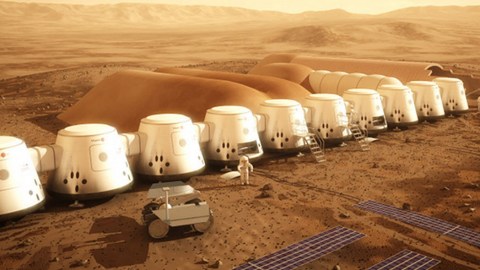The Mission to Mars is Now a Crowdfunded Reality Show

Even if NASA’s Mars Curiosity mission doesn’t end up accomplishing another thing other than establishing the fact that there was once flowing water on the planet’s surface, it will have served an even greater purpose – getting people talking about going to Mars as if it were a reality rather than a science-fiction fantasy. Most recently, the Dutch not-for-profit organization Mars One began accepting applications for a one-way mission to Mars that’s scheduled for 2023 and projected at a total price tag of $6 billion. (Which sounds like a lot, until you realize it’s really just a rounding error when it comes to the sequestered budgets of the U.S. federal government.) Now that Mars Curiosity is roving the planet’s surface, a lot of really smart people – like Apollo astronaut Buzz Aldrin – are talking about the best way not just to plan a Mission to Mars, but also to set up a human colony there.
The most likely scenario, for now, is one that somehow involves NASA. As Marc Kaufman of the Washington Post pointed out in a summary of Mars exploration projects, “NASA remains the indispensable player or partner for any human landing on the surface.” Yet, even with NASA laser-focused on a trip to the Red Planet, the earliest we’d get to Mars is 2030. Buzz Aldrin, in his calculations, envisions a colony by the mid-2030’s.
But what about other, more daring scenarios that project an even earlier arrival date on the Red Planet?
Elon Musk of SpaceX probably thinks we can get to Mars even sooner, and is rumored to be preparing to unveil Mars exploration plans soon. Dennis Tito of International Space Station fame thinks we can get there by 2018 – but that’s just a flyby, not an actual landing. And, Richard Branson’s Virgin Galactic, well, who knows what they might come up with after zipping around the New Mexico desert at supersonic speeds for a few years.
Mars One, however, has captivated imaginations around the world by projecting a 2023 mission to Mars, which means that sometime during our lifetime, we would see a man or woman walk on the Red Planet. Of all the scenarios for a Mars Mission, the Mars One is perhaps the most unorthodox and also the most daring. Some people dismiss it as “far-fetched” or “wildly ambitious.” One of the “ambassadors” for Mars One is one of the original co-creators and producers of the reality TV show “Big Brother,” if that gives you any idea of what to expect.
Checking out the Mars One site, it’s essentially a giant Kickstarter project with reality TV show overtones, where people from around the world toss in anywhere from $5 to $73 for the chance to apply to take a one-way trip to the Red Planet. When I visited the site, “applicants to Mars” included individuals from the USA, the Netherlands, Poland, Saudi Arabia and the Bahamas. You could see which applicants were “popular” and send a little digital love their way if you felt so inclined by voting for them. By some estimates, over 20,000 people from around the world have already applied. Even if you don’t feel like applying for the Mars one-way trip, you can still support the Mars One mission by buying all kinds of merch, the same way you might back a Kickstarter project in exchange for a few swag bag goodies. Mars One posters, for example, sell for $13. You can also make a tax-free donation, natch, since Mars One is also not-for-profit.
It’s easy to mock Mars One, if for no other reason that the idea of average, everyday people paying good money for a remote chance of being selected as an astronaut for a Mars mission sometime in the future strikes one as immediately ludicrous. They say that it’s trivializing space exploration by turning it into a reality show competition. But is it? Even Buzz Aldrin plans to turn space into a competition of sorts, promoting a space camp where “one lucky contestant” will get to fly to outer space. In an interview with the Australian media, Buzz Aldrin described the reality show-like process of finding the next astronaut:
“Some of the activities they will have to do include the G-Centrifuge – a cockpit simulator flying in high-speed circles at the end of a mechanical arm where you experiences force up to 4.5G. The Jet Fighter Flight where you’ll break the speed of sound and even get the chance to flip the plane on its head in mid-air. There is the Zero G Flight which are parabolic flights that will allow you to experience the weightlessness of space. And there is The Astronaut Assault Course, space briefings, one-to-one interviews with astronauts to help participants get ready for space travel and of course, mental aptitude tests.”
If, as Buzz Aldrin writes in Mission to Mars (due out next week), it is “human destiny” to explore space and colonize other planets, then we need to be considering all the options. Getting to Mars is orders of magnitude more difficult than getting to the moon, so the options for financing and then carrying out a mission to the Red Planet will most likely look entirely different from what worked in 1969. Let’s keep the NASA option in our back pocket, but for now, sign me up for the crowdfunded reality show known as the Mission to Mars.
image via Mars One





